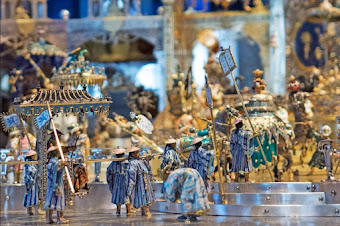Astonishing.
Tuesday, May 24, 2022
Johann Melchior Dinglinger, "The Birthday of the Grand Mughal Aurangzeb"
Johann Melchior Dinglinger (1664 – 1731) was court jeweler to Elector Augustus the Strong of Saxony. He made a whole museum's worth of baubles for his patron, many of which you can see in the Green Vaults in Dresden. The most extraordinary of these is the Birthday of the Grand Mughal Aruangzeb, completed between 1702 and 1708 by Johann and two of his brothers.So far as anybody knows, this was Dinglinger's own conception, not based on any particular work or art or literature. He began it without any special commission from the Elector, but he must have know that Augustus would love it. The Elector was a great lover of pretty things – jewelry, houses, gardens, women – and among other things was responsible for launching Europe's first successful porcelain works at Meissen.
The entire composition measures about 4.3 feet wide, 3.5 feet deep, and 1.9 feet tall (142 x 114 x 58cm). There are 165 separate human and animal figures.
Despite having lost numerous gems over the centuries this is still decorated with 4,909 diamonds, 160 rubies, 164 emeralds, one sapphire, sixteen pearls, and two cameos.
Astonishing.
Astonishing.











Fascinating!
ReplyDeleteInteresting! Although I'm left wondering how it measures up in terms of accuracy to Mughal fashion, design, aesthetic, etc. It seems pretty clear this is a form of Orientalism, but to what degree is it pure fabrication and whimsy, and how much might it actually get sort of right?
ReplyDeleteYou mention it is believed not to be based on any particular work of art of literature, but Aurangzeb was an actual Mughal Padishah, and a rather famous and long-reigning one at that, who ruled during Dinglinger's lifetime. Europeans of the time (privileged ones, anyway) would have had access to all sorts of actual Mughal art and artifacts through the many colonial ventures in the region. Also, looking at the pictures of the figurines, Dinglinger's rendering of Aurangzeb's face seems to bear a good resemblance to how several pieces of Mughal art depict him. There are also pretty plausible looking (to my eye) depictions of what seem to be Qing dynasty Chinese emissaries to the Padishah, replete with queue hairstyles and seemingly accurate (or at least believable) outfits.
I'd love to hear the opinion of a Mughal expert on the relative accuracy of the depictions, but to my very amateur eye, the work seems like it's far from total fabrication, and seems to have involved some decent amount of research and reference, even if it also takes artistic liberties.